

Amber Room
The original Amber Room (Russian
Янтарная комната, German: Bernsteinzimmer) in the Catherine Palace of Tsarskoye
Selo near Saint Petersburg was a complete chamber decoration of amber panels
backed with gold leaf and mirrors. Due to its singular beauty, it was sometimes
dubbed the "Eighth Wonder of the World".
The Amber Room was created from 1701 to 1709 in Prussia and remained at
Charlottenburg Palace until 1716 when it was given by Prussian king Friedrich
Wilhelm I to his then ally, Tsar Peter the Great of the Russian Empire. The
Amber Room was looted during World War II by Nazi Germany and brought to
Königsberg. Knowledge of its whereabouts was lost in the chaos at the end of the
war. Its fate remains a mystery, and the search continues.
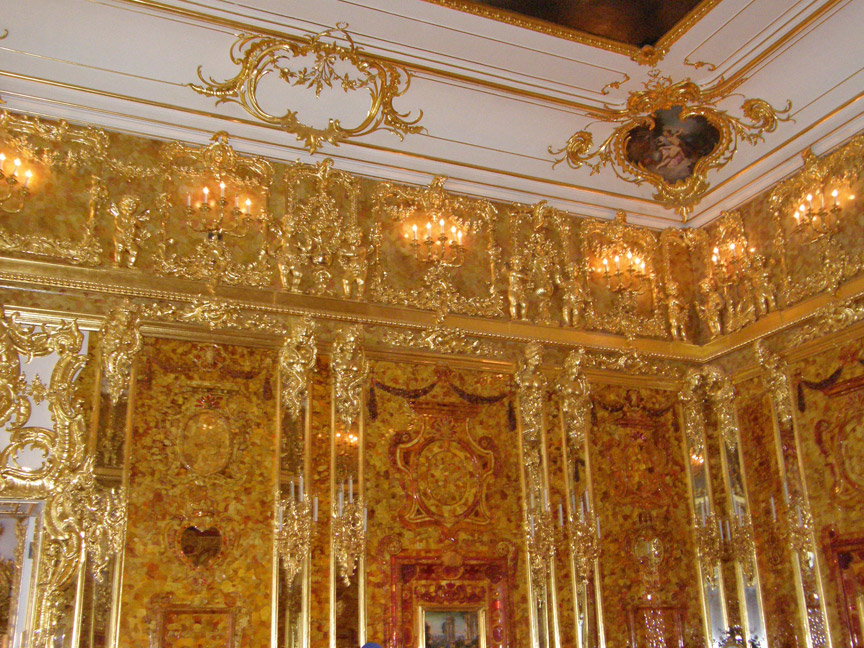
The reconstructed Amber Room was inaugurated in 2003 in the Catherine Palace in
St. Petersburg, Russia.
The Amber Room was made from 1701
onwards in order to be installed at Charlottenburg Palace, home of Friedrich I,
the first king of Prussia, at the urging of his second wife, Sophie Charlotte.
The concept of the room and its design was by Andreas Schlüter. It was crafted
by Gottfried Wolfram, master craftsman to the Danish court of King Frederick IV
of Denmark, with help from the amber masters Ernst Schacht and Gottfried Turau
from Danzig (Gdańsk).
It did not, however, remain at Charlottenburg for long. Peter the Great admired
it on a visit and in 1716, Friedrich Wilhelm I, the first king's son, presented
it to him, and with that act cemented a Prussian-Russian alliance against
Sweden.
In 1755 Tsarina Elizabeth of Russia
had it transferred and installed, first in the Winter Palace, and then in the
Catherine Palace. From Berlin, Frederick II the Great sent her more Baltic
amber, in order to fill out the originals in the new design by the tsarina's
Italian court architect, Bartolomeo Rastrelli.
The Amber Room represented a joint effort of German and Russian craftsmen. After
several other 18th-century renovations, it covered more than 55 square meters
and contained over six tonnes of amber. It took over ten years to construct.
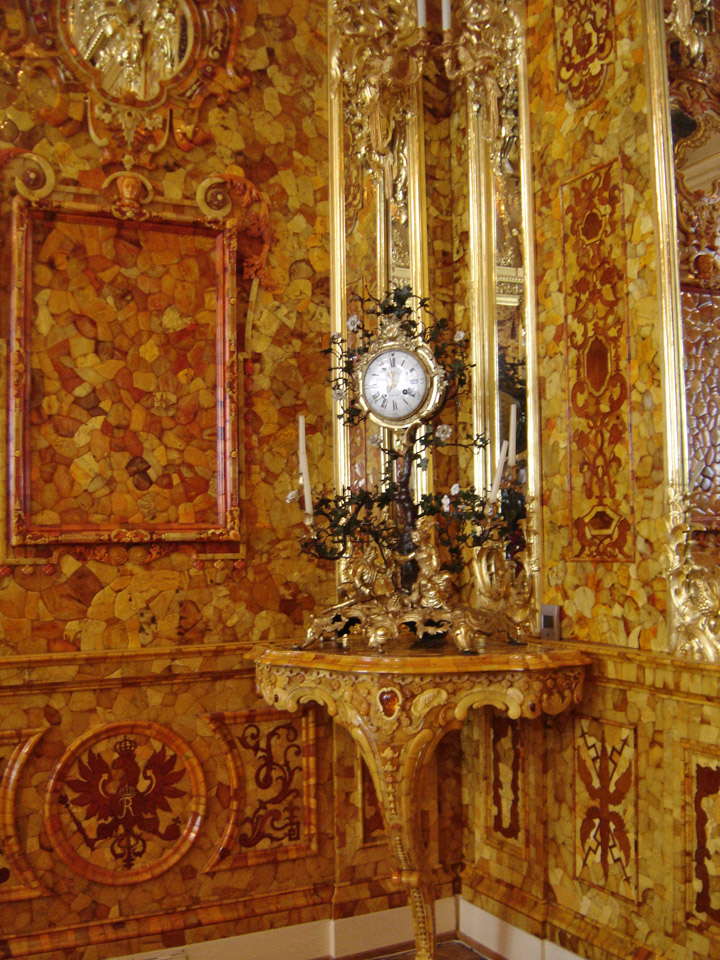
Shortly after the beginning of German invasion of the Soviet Union in World War
II (Operation Barbarossa), the curators responsible for removing the art
treasures in Leningrad tried to disassemble and remove the Amber Room. Over the
years the amber had dried out and become brittle, so that when they tried to
remove it, the fragile amber started to crumble. The Amber Room was therefore
hidden behind mundane wallpaper, in an attempt to keep Nazi forces from seizing
it. However, this attempt to hide a well-known piece of art in such a manner
failed.
As the palace had been hit by grenades, German soldiers disassembled the Amber
Room within 36 hours under the supervision of two experts, in accordance with
Hague Conventions. On 14 October 1941, Rittmeister Graf Solms-Laubach commanded
the evacuation of 27 crates to Königsberg (renamed Kaliningrad in 1946) in East
Prussia, for storage and display in the town's castle. On 13 November 1941, the
newspaper Königsberger Allgemeine Zeitung reported about an exhibition of part
of the Bernsteinzimmer in Königsberg Castle.
Orders by Hitler given on 21 January 1945 and 24 January 1945 allowed the
movement of possessions. From that day onwards, Albert Speer's administration
could move culture goods of priority. Erich Koch was in charge in Königsberg.
Eyewitnesses claimed that crates had been sighted at the railway station. They
might have been put aboard the Wilhelm Gustloff which left Gdingen on January
30, and was sunk by a Soviet submarine. Another possible location is Weimar, the
location of a planned propaganda center.
Later in the war, Königsberg was heavily bombed by the Royal Air Force. It
suffered further heavy damage at the hands of the advancing Soviets before and
after its fall on April 9, 1945.
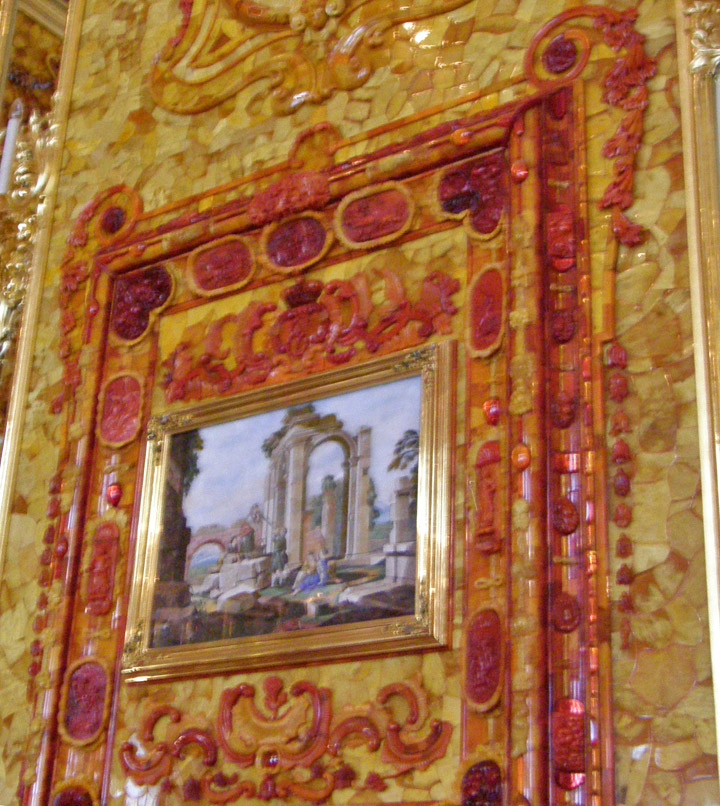
The Amber Room was never seen again, though reports have occasionally surfaced
stating that components of the Amber Room survived the war.
There have been numerous conflicting reports and theories, among them that the
Amber Room was destroyed by bombing, hidden in a now-lost subterranean bunker in
Königsberg, buried in mines in the Ore Mountains, or taken onto a ship or
submarine which was sunk by Soviet forces in the Baltic Sea.
Many different individuals and groups, including a number of different entities
from the government of the Soviet Union, have mounted extensive searches for it
at various times since the war, with little result. At one point in 1998, two
separate teams (one in Germany, the other in Lithuania) announced that they had
located the Amber Room, the first in a silver mine, the second buried in a
lagoon; neither produced the Amber Room.
However, in 1997 one Italian stone mosaic that was part of a set of four which
had decorated the Amber Room did turn up in western Germany, in the possession
of the family of a soldier who had helped pack up the Amber Room.
Recently, British investigative journalists Catherine Scott-Clark and Adrian
Levy, conducted lengthy research on the fate of the Amber Room, including
extensive archival research in Russia. In 2004 their book, The Amber Room: The
Fate of the World's Greatest Lost Treasure, concluded that the Amber Room was
most likely destroyed when Königsberg Castle was burned out, shortly after
Königsberg surrendered to occupying Soviet forces.
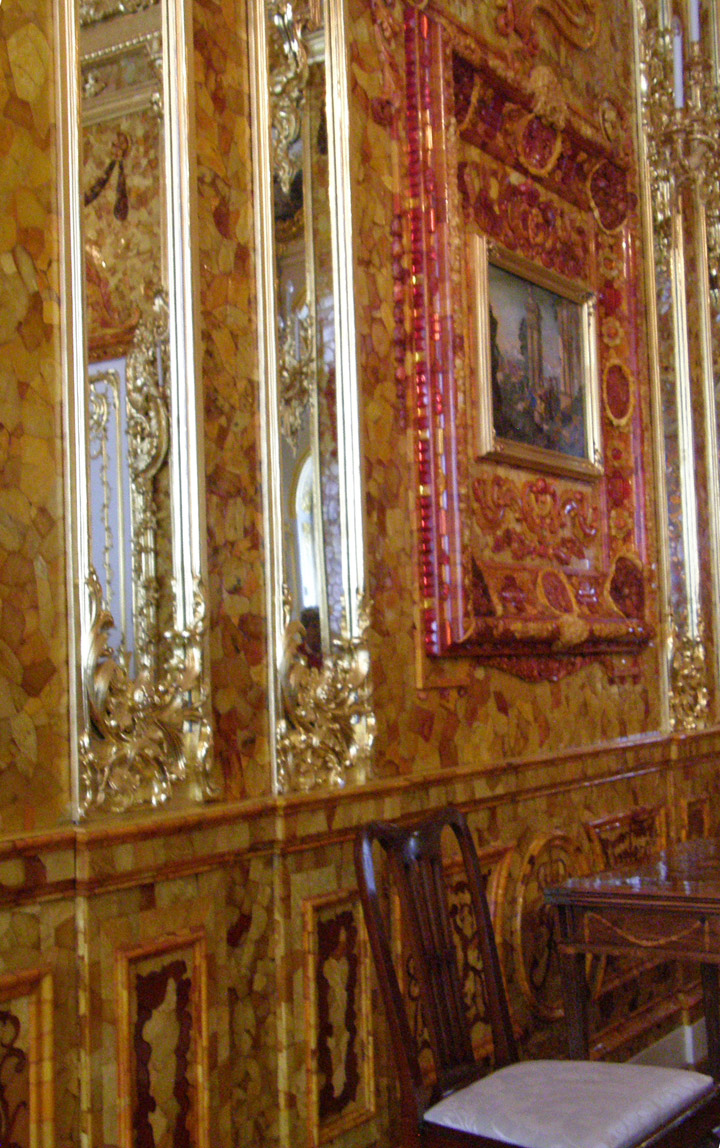
Documents from the archives showed that that was also the conclusion of the
report of Alexander Brusov, chief of the first formal mission sent by the Soviet
government to find the Amber room, who wrote in June, 1945: "Summarizing all the
facts, we can say that the Amber Room was destroyed between 9 and 11 April
1945". [3] Some years later, Brusov later gave a contrary opinion; the book
authors intimate that this change of opinion was likely due to pressure from
other Soviet officials, who did not want to be seen as responsible for the loss
of the Amber Room.
Among other information from the archives was the revelation that the remains of
the rest of the set of Italian stone mosaics were found in the burned debris of
the castle. The authors' reasoning as to why the Soviets conducted extensive
searches for the Amber Room in the years after WWII, even though their own
experts had concluded that it was destroyed, is that it served the differing
motives of several elements in the Soviet government: some wished to obscure
(even from other branches of the Soviet government) the fact that Soviet
soldiers may have been responsible for its destruction; others found the theft
of the Amber Room a useful Cold War propaganda tool, and did not want to let go
of a grievance that could be aired advantageously; still others did not want to
share the blame for its destruction (through their failure to evacuate the Amber
Room to safety at the start of the war).
Russian officials have denied the book's conclusions - angrily, in some cases.
Said Adelaida Yolkina, senior researcher at the Pavlovsk Museum Estate: "It is
impossible to see the Red Army being so careless that they let the Amber Room be
destroyed." Other Russian experts were less sceptical, and had a different
emphasis in their responses. Mikhail Piotrovsky, director of the State Hermitage
Museum, was very cautious in his comments, and said: "Most importantly, the
destruction of the Amber Room during the Second World War is fault of the people
who started the war". In reply, Catherine Scott-Clark, one of the authors,
indicated that they only came to their conclusions with reluctance: "when we
started working on this issue we were hoping to be able to find the Amber Room."
Since the book came out, a Russian
veteran has given an interview in which he confirmed their basic conclusion as
to the fate of the Amber Room, although he denies that the fires were
deliberate. "I probably was one of the last people who saw the Amber Room", said
Leonid Arinshtein, a literature expert with the nongovernmental Russian Culture
Foundation, who was a Red Army lieutenant in charge of a rifle platoon in
Königsberg in 1945. "The Red Army didn't burn anything", he said.
A variation of this theory is common currency amongst present-day residents of
Kaliningrad. This is that part at least of the room was found in the cellars
after WWII by the Red Army, in relatively good condition. This was not admitted
at the time in order that blame should continue to rest upon the Germans. To
preserve this story access to the ruins of the castle, which were substantial
after WWII, was restricted, even to historical/archaeological surveys. During
the 1960s, access to the site was suddenly withheld and the ruins were blown up
by the Army, sealing any access to the underground area. The still uncompleted
Dom Sovietov was built over the central area. The remains of the room may still
be sited underground; however, as mentioned above, amber which is not cared for
will crumble into dust. It is presumed that this is what has happened and that
the Russian authorities, even after Communism, have been unwilling to admit
this.
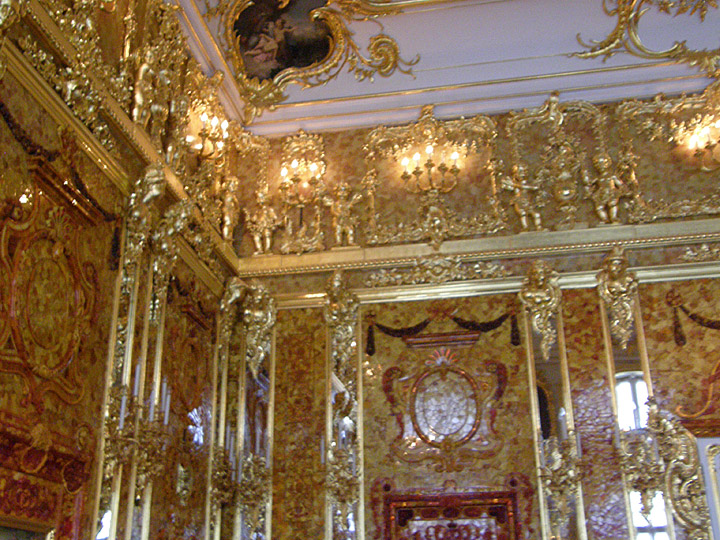
reconstructed Amber room
In 1979 a reconstruction effort began
at Tsarskoye Selo, based largely on black and white photographs of the original
Amber Room. Financial difficulties to the project were solved with 3.5 million
American dollars donated by the German company Ruhrgas AG. By 2003 the titanic
work of the Russian craftsmen was mostly completed. The new room was dedicated
by Russian President Vladimir Putin and German Chancellor Gerhard Schröder at
the 300-year anniversary of the city of Saint Petersburg.
In Kleinmachnow, near Berlin, there is a miniature Amber Room, fabricated after
the original. The Berlin miniature collector Ulla Klingbeil had this copy made
of original East Prussian amber.
Text from Wikipedia
Palace furnishings
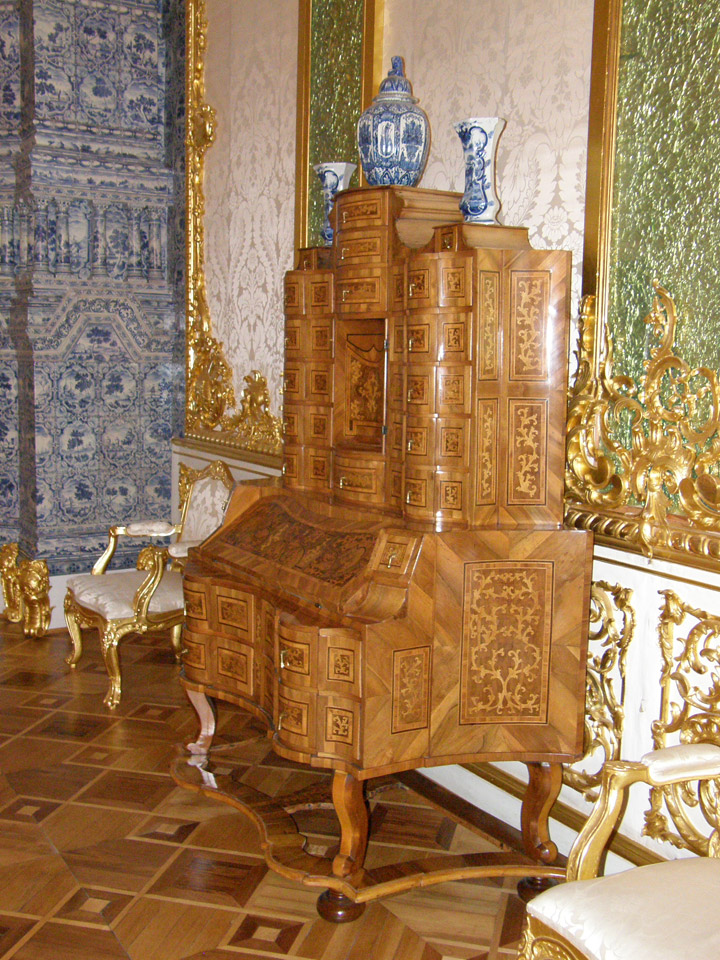

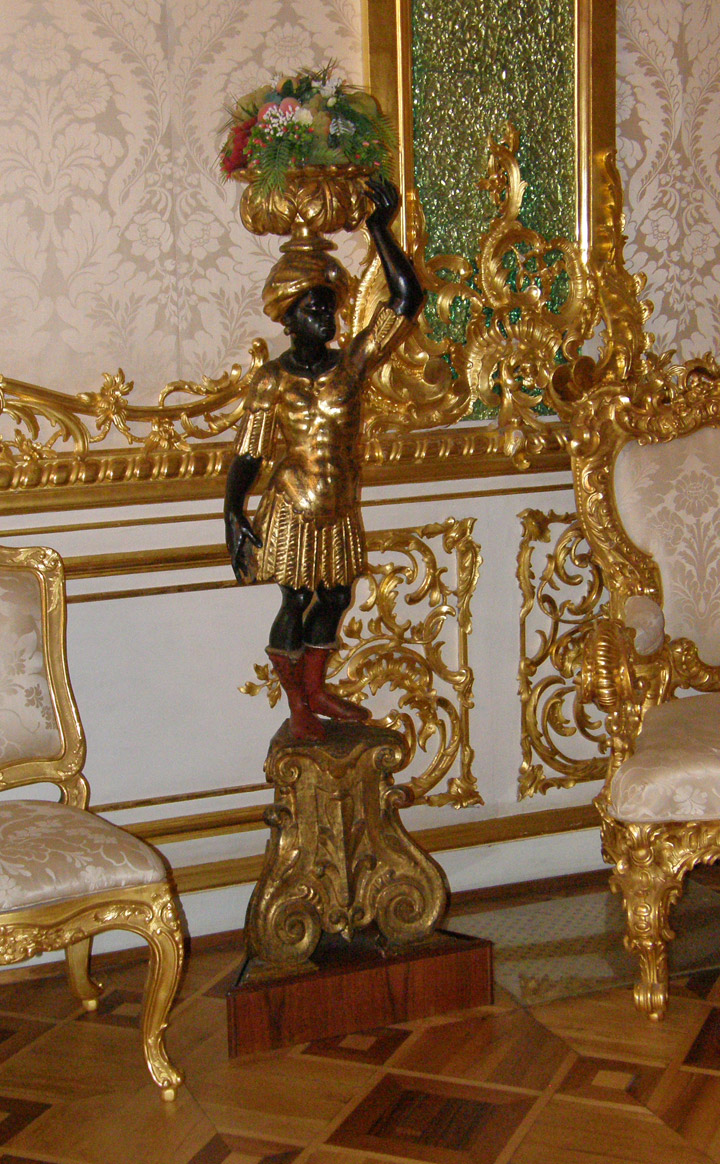
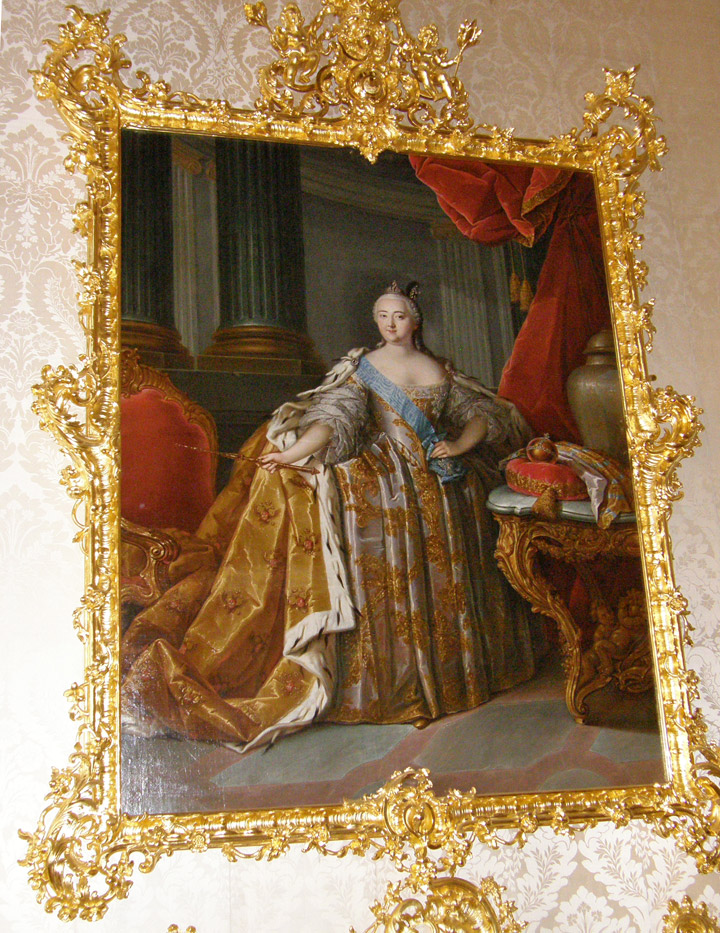
Catherine
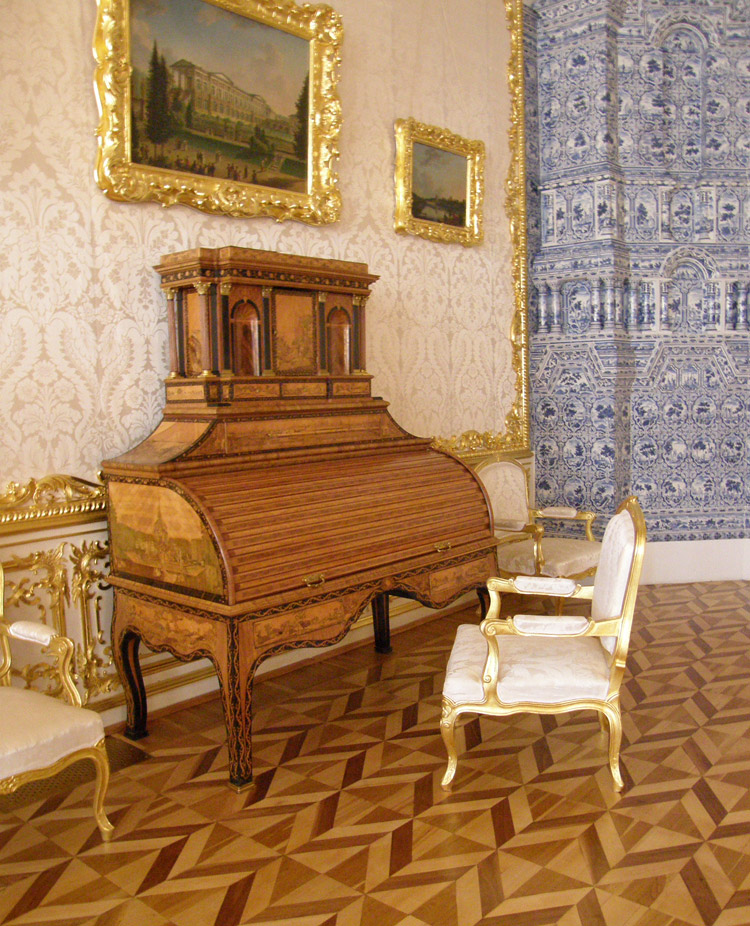
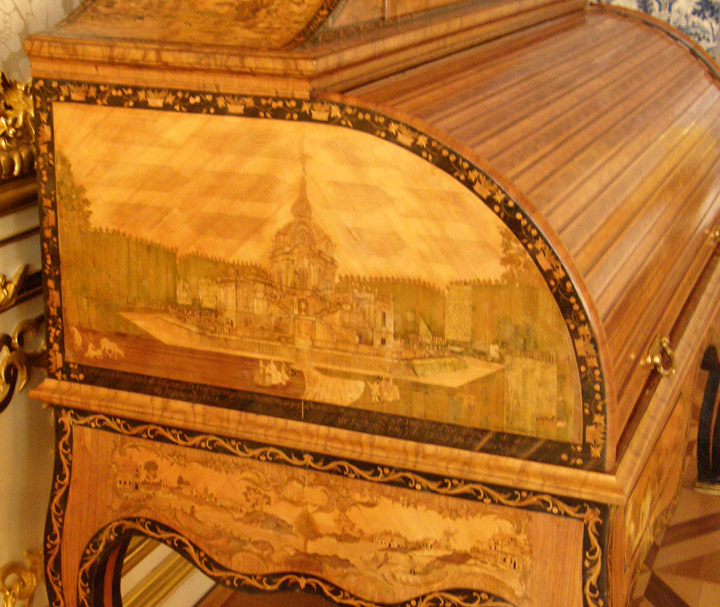
detail of wood inlay on the end of the desk